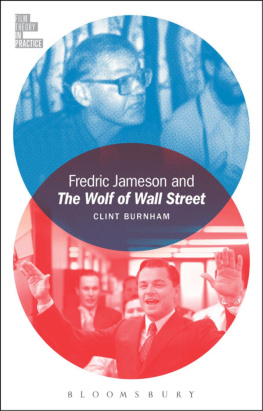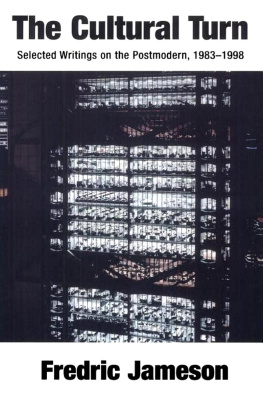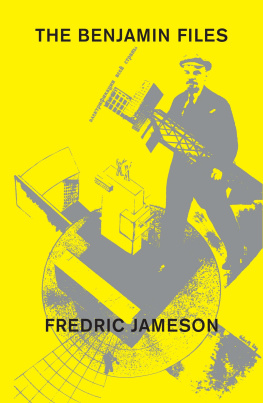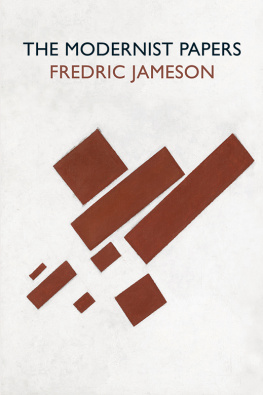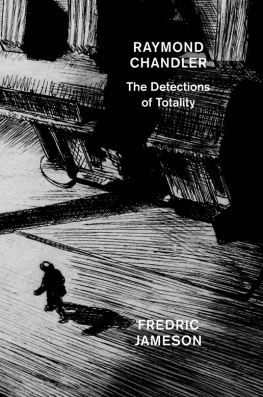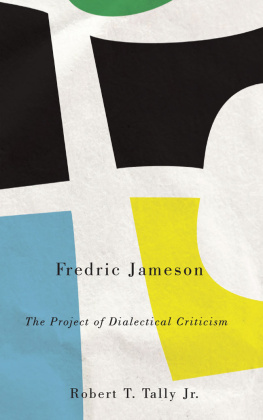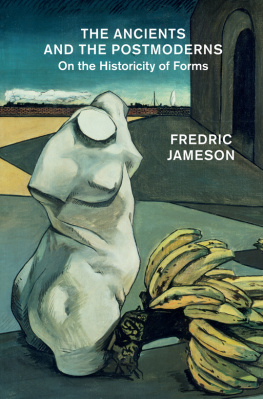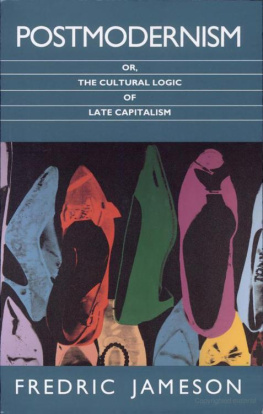Burnham Clint - Fredric Jameson and the Wolf of Wall Street
Here you can read online Burnham Clint - Fredric Jameson and the Wolf of Wall Street full text of the book (entire story) in english for free. Download pdf and epub, get meaning, cover and reviews about this ebook. year: 2019, publisher: Bloomsbury Academic & Professional, genre: Romance novel. Description of the work, (preface) as well as reviews are available. Best literature library LitArk.com created for fans of good reading and offers a wide selection of genres:
Romance novel
Science fiction
Adventure
Detective
Science
History
Home and family
Prose
Art
Politics
Computer
Non-fiction
Religion
Business
Children
Humor
Choose a favorite category and find really read worthwhile books. Enjoy immersion in the world of imagination, feel the emotions of the characters or learn something new for yourself, make an fascinating discovery.
- Book:Fredric Jameson and the Wolf of Wall Street
- Author:
- Publisher:Bloomsbury Academic & Professional
- Genre:
- Year:2019
- Rating:4 / 5
- Favourites:Add to favourites
- Your mark:
- 80
- 1
- 2
- 3
- 4
- 5
Fredric Jameson and the Wolf of Wall Street: summary, description and annotation
We offer to read an annotation, description, summary or preface (depends on what the author of the book "Fredric Jameson and the Wolf of Wall Street" wrote himself). If you haven't found the necessary information about the book — write in the comments, we will try to find it.
Fredric Jameson and the Wolf of Wall Street — read online for free the complete book (whole text) full work
Below is the text of the book, divided by pages. System saving the place of the last page read, allows you to conveniently read the book "Fredric Jameson and the Wolf of Wall Street" online for free, without having to search again every time where you left off. Put a bookmark, and you can go to the page where you finished reading at any time.
Font size:
Interval:
Bookmark:
Fredric Jameson
and The Wolf
of Wall Street
FILM THEORY IN PRACTICE
Series Editor: Todd McGowan
Editorial Board
Slavoj iek, University of Ljubljana, Slovenia
Joan Copjec, Brown University, USA
Hilary Neroni, University of Vermont, USA
Jennifer Friedlander, Pomona College, USA
Fabio Vighi, University of Cardiff, UK
Hugh Manon, Clark University, USA
Paul Eisenstein, Otterbein University, USA
Hyon Joo Yoo, University of Vermont, USA
Louis-Paul Willis, University of Quebec, Canada
FILM THEORY IN PRACTICE
Fredric Jameson
and The Wolf
of Wall Street
CLINT BURNHAM
Bloomsbury Academic
An imprint of Bloomsbury Publishing Inc

This book is for Tim Lee: lets go to the movies
Scorsese/Jameson
Relying on Fredric Jamesons brand of Marxist theory to criticize Martin Scorseses film about Wall Street would seem to be a gimme: what could be more obviously a capitalist film than one about capitalism? The answer to that question is this book itself, and by way of introducing its argument, I want to first offer a synopsis of the film, then introduce Jamesons system of thought, his ways of reading film and other cultural objects, and finally, drawing on those ideas, situate Scorseses movie in the context of current films on the economic crisis.
The Wolf of Wall Street begins with a mock commercial for the Stratton Oakmont brokerage that quickly shifts to a dwarf-tossing contest in the firm, followed by a montage of Jordan Belforts (Leonardo DiCaprio) life: a sports car, model wife, drugs and prostitutes, drunken helicopter rides. Money, Belfort tells us, is his real drug, and we then see the bare bones of his rise to fame, starting with a job where he is taken under the wing of the hedonistic Mark Hanna, who snorts coke at three-martini lunches and suggests masturbation as a counter to the cerebral work of selling stocks. But the crash of October 1989 ends Belforts first job, and soon he is reduced to working at a penny stock outfit, a boiler room operation, out of a Long Island strip mall. Now his selling genius holds him in good stead for, instead of the 1 percent commission made selling blue-chip stocks, here brokers earn a 50 percent commission. Belfort assembles a team of salesmen from his motley crew of friends: would-be drug dealers and the like, most notably Donnie Azoff. As Belforts career and corporate success ramps up (even before he sets up his own shop, he is making $70,000 a month), we see him reel in customers over the phone, inspire his sales team with images out of Moby-Dick, and, crucially, entertain the workers with weekly scenes of debauchery: half-naked marching bands; alcohol, drugs, and prostitutes; sex in the elevator and exotic pets (boa constrictor, chimpanzee) on the trading floor. Belfort meets Naomi, the Duchess of Bay Ridge, and they are soon living in a Manhattan apartment complete with a gay butler, then marry in the Bahamas (Belfort gives his wife a yacht called the Naomi), and settle into life on Long Islands Gold Coast, Belforts appetite for drugs and illicit sex not impeded whatsoever.
Attention from outside his circle comes from two directions: first, a profile in Esquire magazine gives Belfort the moniker the Wolf of Wall Street, a name that his friends now call him, but which is also his safe word (Wolfie) in sex games with a dominatrix mistress. But interest in Belforts unorthodox stock trading is also building with the FBI. This has all taken place in the first hour of the film, its first act, as it were, and the second depicts Belforts accelerated money-making and money-spending, both legal and illegal, simultaneous with increased interest from law enforcement. The center of the films plot turns out to be an IPO (or Initial Public Offering of stocks) for a shoe company, which, handled by Stratton Oakmont, is also a way for Belfort, via his rathole friends who hold stocks illegally, to make 22 million dollars in a few hours. Such profits mean the cash has to be stashed somewhere, and so a scheme is hatched to smuggle it into Switzerland, in luggage or, improbably, wrapped around womens bodies. In the films final hour/act, things descend in a downward spiral: people are arrested, Belfort and friends endure a horrific storm on their yacht, he is under house arrest, engages in some played-for-laughs domestic violence, and ends up in jail. The film ends with Belfort, as in real life, back on his feet as a motivational speaker.
The films first message is clear, if ambiguous: being a stock broker is a lot of fun, but are we to disapprove of the lifestyle? This is a common ambiguity to be found in many of Scorseses films: do we admire Charlie in Mean Streets (1973) or Travis Bickle in Taxi Driver (1975) or Henry Hill in Goodfellas (1990), or do we wag our fingers at their foul mouths, larceny, and violence? Is the libidinal excess of The Wolf of Wall Street an indictment of the rich, a post-Occupy Wall Street allegory, a moral critique, or is the film merely a vapid pop culture artifact, complete with the violence, misogyny, and consumerism utterly typical of contemporary American entertainment?
As may be expected, an interpretation of The Wolf of Wall Street developing out of Fredric Jamesons film theory will do more than fall into such a dualistic and false debate. Fundamentally, a Jamesonian critique will always be both immanent and symptomatic. Immanent in the sense coming out of Hegel and the Frankfurt School, which is to seek to interpret a cultural object on its own terms, finding the contradictions inherent in a philosophical or literary project, rather than holding it up to an external standard. Symptomatic in a post-Freudian sense, that reads the film or text for what is repressed or excluded, but not to make a psychoanalytic argument with respect to individual psyches or traumas, and instead with the goal of arriving at a social critique embedded in that film or text. For Jameson, films and other cultural objects always make possible a Utopian critique or account of the historical present. Such an account, Jameson argues, is not so much present in surface readings that are enthralled with what the film wants to tell us as in the films political unconscious, in its non-dit, its unsaid, what the film seeks to repress or exclude (or to contain as a form of co-optation).
Thus, Jameson argues that classic 1970s films like Jaws (Steven Spielberg, 1975), The Godfather (Francis Ford Coppola, 1972), Dog Day Afternoon (Sidney Lumet, 1975), and All the Presidents Men (Alan J. Pakula, 1976) are attempts, respectively, to negotiate American postwar history, or to critique capitalism via the mob, or to think about class in our mediatized present, or even to think about global capitalism as a totality via representations of conspiracy. If The Godfather was a mob film that was really about corporate capitalism, perhaps The Wolf of Wall Street is a Scorsese gangster film in the guise of an indictment of finance capital. And thus Belforts crew of salesmen, many of whom are petty criminals, is not only a kind of heist picture motif, but also an allegory (a privileged technique for Jameson) of the collective, of the possibilities of a class revolt. In addition, Jameson is a key theorist of postmodernism, and so we can see that the films turn to other mediaits incessant use of real and made-up commercials, for instanceis a way of situating the modernist medium of film in a post-cinematic landscape. A media ecology where immaterial labor and objects, the existential threat of downloading, and misleading film trailers are the new normal (thus one trailer for the film was scored with Kanye Wests song Black Skinhead, which does not appear in the actual film or on its soundtrack).
Next pageFont size:
Interval:
Bookmark:
Similar books «Fredric Jameson and the Wolf of Wall Street»
Look at similar books to Fredric Jameson and the Wolf of Wall Street. We have selected literature similar in name and meaning in the hope of providing readers with more options to find new, interesting, not yet read works.
Discussion, reviews of the book Fredric Jameson and the Wolf of Wall Street and just readers' own opinions. Leave your comments, write what you think about the work, its meaning or the main characters. Specify what exactly you liked and what you didn't like, and why you think so.

